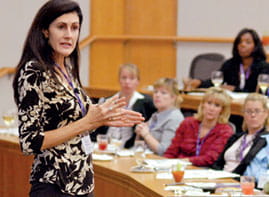Loran Nordgren finds that people underestimate the social pain and trauma suffered by bully victims
1/3/2011 - Taunted, harassed and pushed to a deadly breaking point. Last year, stories of teen bullying brought to life the heartbreaking consequences of young lives cut short by ruthless and unchecked behavior. Recent media coverage of these violent acts has heightened the awareness of the deadly consequences of bullying, but has done little to stop it from happening.
According to a new Kellogg School study, people fail to understand the consequences of the social trauma experienced by victims of bullying, teasing and ostracism. This “empathy gap” can be devastating because it means victims often do not get the support, intervention or advocacy they need.
“Everyone knows that social trauma is unpleasant, but people are often blind to the full severity of these experiences and therefore don’t do enough to protect or intervene when victims suffer,” said study leader Loran Nordgren, assistant professor of management and organizations. “News stories in recent months centered around bully victims who took their own lives out of desperation and fear, whether harassed physically in school, or emotionally via text message, online or through social networks. Only by having a heightened sense of empathy to victims’ true suffering can we begin to pave the way for reform and new policies.”
The research suggests that people have difficulty appreciating the full severity of social suffering unless they themselves experience it. The findings show that an understanding of this empathy gap, especially in the case of bullying, is crucial because it has implications for how outsiders react to socially distressing events and the degree of punitive measures that are taken in support of victims.
The study, “Empathy Gaps for Social Pain: Why People Underestimate the Pain of Social Suffering” is featured in the current issue of Journal of Personality and Social Psychology and was conducted by Nordgren, Kasia Banas of the University of Edinburgh and Geoff MacDonald of the University of Toronto.
To explore their theory — that only by identifying with a victim’s social suffering can one understand its devastating effects — the researchers conducted five experiments that simulated a socially painful event. In four of the experiments, participants were asked to play a computer ball-toss game. By using a social exclusion manipulation, the study concluded that those participants who were included in the activity consistently underestimated the severity of social pain compared to excluded participants, who had a heightened appreciation of its effects.
A fifth experiment asked middle-school teachers to evaluate policies regarding emotional bullying at school. Those teachers who personally experienced social exclusion had a heightened perception of the pain caused by emotional bullying, which led them to implement punishment for students who bully and more comprehensive treatment for bullied students.
“Statistics show that 25 percent of public schools have reported that bullying occurs among students on a daily or weekly basis1, and 43 percent of students have experienced some form of cyber-bullying2. While educators and policy makers have developed programs and laws to prevent incidents of bullying, our research suggests this may not be enough,” argues Nordgren. “Only when students, teachers and school administrators partake in exercises or training that simulate a socially painful event, like bullying, can they be truly empathetic to its consequences.”
According to Nordgren, future research aimed at improving public policy should consider ways of closing the empathy gap as a means to correct distorted judgments of social pain, such as improved counseling for bullied students or simulating self-induced mild states of social pain to heighten understanding of others’ pain.
“All told, our perception of social pain matters as much as our understanding of physical pain. Not only do estimates of social pain govern how we empathize with socially traumatic events, but they guide our approach to how well we advocate on a victim’s behalf,” he concluded.
MORE INFORMATION: To arrange an interview with Professor Nordgren, contact Betsy Berger.
1 Simone Rovers, Jijun Zhang, Jennifer Truman, and Thomas D. Snyder, “Indicators of School Crime and Safety: 2010,” National Center for Education Statistics, (2010): iv, http://bjs.ojp.usdoj.gov/content/pub/pdf/iscs10.pdf
2 Chris Mossener, “Cyber Bullying,” National Crime Prevention Council, (2007): 2, http://www.ncpc.org/resources/files/pdf/bullying/Cyberbullying%20Trends%20-%20Tudes.pdf






